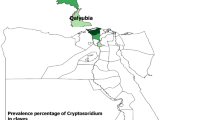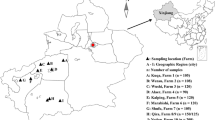Abstract
Cryptosporidiosis has been reported as an important cause of neonatal diarrhea and mortality in cattle, sheep, and other ruminants, but its impact on alpaca health has not been studied thoroughly. In this study, we have determined the prevalence and evaluated the role of cryptosporidiosis as a risk factor for diarrhea occurrence in newborn alpacas. During the calving season (January–March) of 2006, stool specimens (N = 1312) were collected from 24 herds of newborn alpacas in Puno and Cuzco, departments that account for the largest populations of alpacas in Peru. All the specimens were microscopically screened for Cryptosporidium spp. using the acid-fast technique. The association between Cryptosporidium detection and diarrhea was analyzed using χ2 test and generalized lineal model. Cryptosporidium species were determined by PCR-RFLP analysis of the small subunit rRNA gene. Cryptosporidium oocysts were detected in 159 of 1312 (12.4%) newborn alpacas. Results of the analyses demonstrated that crypstosporidiosis was significantly associated with diarrhea (PR = 3.84; CI95% 2.54–5.81; p < 0.0001). Only Cryptosporidium parvum was detected in the 153 Cryptosporidium-infected animals. Thus, there is an association of C. parvum infection with diarrhea in neonatal alpacas.


Similar content being viewed by others
References
Bidewell CA, Cattell JH (1998) Cryptosporidiosis in young alpacas. Vet Rec 142(11):287
Burton AJ, Nydam DV, Mitchell KJ, Bowman DD (2012) Fecal shedding of Cryptosporidium oocysts in healthy alpaca crias and their dams. J Am Vet Med Assoc 241(4):496–498. https://doi.org/10.2460/javma.241.4.496
Cebra CK, Mattson DE, Baker RJ, Sonn RJ, Dearing PL (2003) Potential pathogens in feces from unweaned llamas and alpacas with diarrhea. J Am Vet Med Assoc 223(12):1806–1808
Checkley W, White AC Jr, Jaganath D, Arrowood MJ, Chalmers RM, Chen XM, Fayer R, Griffiths JK, Guerrant RL, Hedstrom L, Huston CD, Kotloff KL, Kang G, Mead JR, Miller M, Petri WA Jr, Priest JW, Roos DS, Striepen B, Thompson RC, Ward HD, van Voorhis W, Xiao L, Zhu G, Houpt ER (2015) A review of the global burden, novel diagnostics, therapeutics, and vaccine targets for Cryptosporidium. Lancet Infect Dis 15(1):85–94. https://doi.org/10.1016/S1473-3099(14)70772-8
Delafosse A, Chartier C, Dupuy MC, Dumoulin M, Pors I, Paraud C (2015) Cryptosporidium parvum infection and associated risk factors in dairy calves in western France. Prevent Vet Med 118(4):406–412. https://doi.org/10.1016/j.prevetmed.2015.01.005
Feng Y, Ortega Y, He G, Das P, Xu M, Zhang X, Fayer R, Gatei W, Cama V, Xiao L (2007) Wide geographic distribution of Cryptosporidium bovis and the deer-like genotype in bovines. Vet Parasitol 144(1-2):1–9. https://doi.org/10.1016/j.vetpar.2006.10.001
Feng Y, Ryan UM, Xiao L (2018) Genetic diversity and population structure of Cryptosporidium. Trends Parasitol 34(11):997–1011. https://doi.org/10.1016/j.pt.2018.07.009
Gomez-Couso H et al (2012) Presence and molecular characterisation of Giardia and Cryptosporidium in alpacas (Vicugna pacos) from Peru. Vet Parasitol 187(3-4):414–420. https://doi.org/10.1016/j.vetpar.2012.01.025
Henriksen SA, Pohlenz JF (1981) Staining of cryptosporidia by a modified Ziehl-Neelsen technique. Acta Vet Scand 22(3-4):594–596
Jiang J, Alderisio KA, Singh A, Xiao L (2005) Development of procedures for direct extraction of Cryptosporidium DNA from water concentrates and for relief of PCR inhibitors. Appl Environ Microbiol 71(3):1135–1141. https://doi.org/10.1128/AEM.71.3.1135-1141.2005
Koehler AV, Rashid MH, Zhang Y, Vaughan JL, Gasser RB, Jabbar A (2018) First cross-sectional, molecular epidemiological survey of Cryptosporidium, Giardia and Enterocytozoon in alpaca (Vicugna pacos) in Australia. Parasit Vectors 11(1):498. https://doi.org/10.1186/s13071-018-3055-6
Lopez MT, Gonzalez AE, Rojo-Vazquez FA (2001) Infección experimental de alpacas neonatas con Cryptosporidium parvum. Rev Acad Per Cienc Vet 2:11–17
Lopez-Urbina MT et al (2009) Prevalence of neonatal cryptosporidiosis in Andean alpacas (Vicugna pacos) in Peru. Open Parasitol J 3:9–13
Majeed QAH, el-Azazy OME, Abdou NMI, al-Aal ZA, el-Kabbany AI, Tahrani LMA, AlAzemi M, Wang Y, Feng Y, Xiao L (2018) Epidemiological observations on cryptosporidiosis and molecular characterization of Cryptosporidium spp. in sheep and goats in Kuwait. Parasitol Res 117(5):1631–1636. https://doi.org/10.1007/s00436-018-5847-1
Maurya PS, Rakesh RL, Pradeep B, Kumar S, Kundu K, Garg R, Ram H, Kumar A, Banerjee PS (2013) Prevalence and risk factors associated with Cryptosporidium spp. infection in young domestic livestock in India. Trop Anim Health Prod 45(4):941–946. https://doi.org/10.1007/s11250-012-0311-1
Nguyen ST et al (2012) Prevalence and risk factors associated with Cryptosporidium oocysts shedding in pigs in Central Vietnam. Res Vet Sci 93(2):848–852. https://doi.org/10.1016/j.rvsc.2012.01.007
Pedersen SH, Wilkinson AL, Andreasen A, Warhurst DC, Kinung'hi SM, Urassa M, Mkwashapi DM, Todd J, Changalucha J, McDermid J (2014) Cryptosporidium prevalence and risk factors among mothers and infants 0 to 6 months in rural and semi-rural Northwest Tanzania: a prospective cohort study. PLoS Negl Trop Dis 8(10):e3072. https://doi.org/10.1371/journal.pntd.0003072
Rulofson FC, Atwill ER, Holmberg CA (2001) Fecal shedding of Giardia duodenalis, Cryptosporidium parvum, Salmonella organisms, and Escherichia coli O157:H7 from llamas in California. Am J Vet Res 62(4):637–642
Ryan U, Zahedi A, Paparini A (2016) Cryptosporidium in humans and animals - a one health approach to prophylaxis. Parasite Immunol 38(9):535–547. https://doi.org/10.1111/pim.12350
Ryan U, Hijjawi N, Xiao L (2018) Foodborne cryptosporidiosis. Int J Parasitol 48(1):1–12. https://doi.org/10.1016/j.ijpara.2017.09.004
Santin M (2013) Clinical and subclinical infections with Cryptosporidium in animals. N Z Vet J 61(1):1–10. https://doi.org/10.1080/00480169.2012.731681
Starkey SR, Johnson AL, Ziegler PE, Mohammed HO (2007) An outbreak of cryptosporidiosis among alpaca crias and their human caregivers. J Am Vet Med Assoc 231(10):1562–1567. https://doi.org/10.2460/javma.231.10.1562
Szonyi B, Chang YF, Wade SE, Mohammed HO (2012) Evaluation of factors associated with the risk of infection with Cryptosporidium parvum in dairy calves. Am J Vet Res 73(1):76–85. https://doi.org/10.2460/ajvr.73.1.76
Thomson S, Hamilton CA, Hope JC, Katzer F, Mabbott NA, Morrison LJ, Innes EA (2017) Bovine cryptosporidiosis: impact, host-parasite interaction and control strategies. Vet Res 48(1):42. https://doi.org/10.1186/s13567-017-0447-0
Twomey DF et al (2008) Cryptosporidiosis in two alpaca (Lama pacos) holdings in the South-West of England. Vet J 175(3):419–422. https://doi.org/10.1016/j.tvjl.2007.01.017
Waitt LH, Cebra CK, Firshman AM, McKenzie EC, Schlipf JW Jr (2008) Cryptosporidiosis in 20 alpaca crias. J Am Vet Med Assoc 233(2):294–298. https://doi.org/10.2460/javma.233.2.294
Weitz JC, Astorga B (1993) Cryptosporidium parvum in patients with chronic diarrhea and AIDS: diagnosis by means of indirect immunofluorescence with monoclonal antibodies. Rev Med Chil 121(8):923–926
Whitehead CE, Anderson DE (2006) Neonatal diarrhea in llamas and alpacas. J Small Rum Res 61:207–215. https://doi.org/10.1016/j.smallrumres.2005.07.012
Xiao L (2010) Molecular epidemiology of cryptosporidiosis: an update. Exp Parasitol 124(1):80–89. https://doi.org/10.1016/j.exppara.2009.03.018
Author information
Authors and Affiliations
Corresponding author
Ethics declarations
This study was reviewed and approved (protocol no. 2006-003) by the Institutional Ethics Committee for the Use of Animals (Comite de Ética y Bienestar Animal (CEBA)) at the School of Veterinary Medicine, Universidad Nacional Mayor de San Marcos in Lima, Peru. Also, all owners signed an informed consent for the sample collection of their alpaca crias, where the anonymity of the data is mentioned.
Conflict of interest
The authors declare that they have no conflict of interest.
Additional information
Handling Editor: Una Ryan
Publisher’s note
Springer Nature remains neutral with regard to jurisdictional claims in published maps and institutional affiliations.
Rights and permissions
About this article
Cite this article
Gomez-Puerta, L.A., Gonzalez, A.E., Vargas-Calla, A. et al. Cryptosporidium parvum as a risk factor of diarrhea occurrence in neonatal alpacas in Peru. Parasitol Res 119, 243–248 (2020). https://doi.org/10.1007/s00436-019-06468-7
Received:
Accepted:
Published:
Issue Date:
DOI: https://doi.org/10.1007/s00436-019-06468-7




